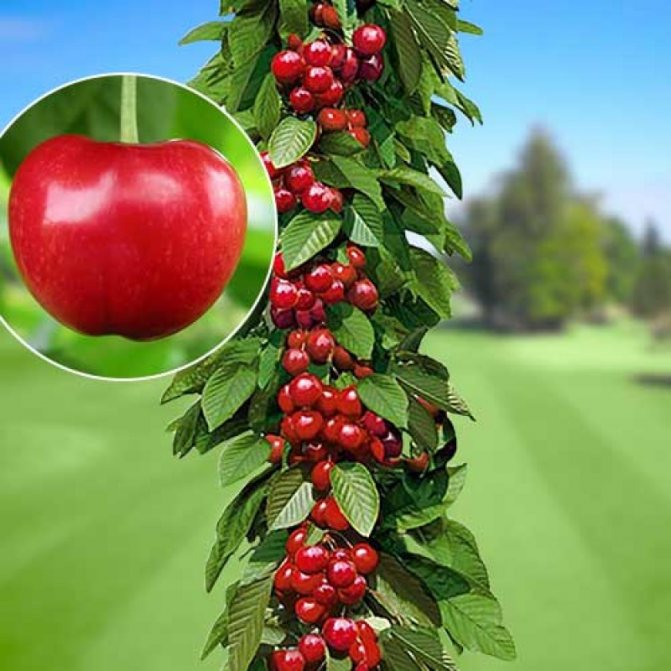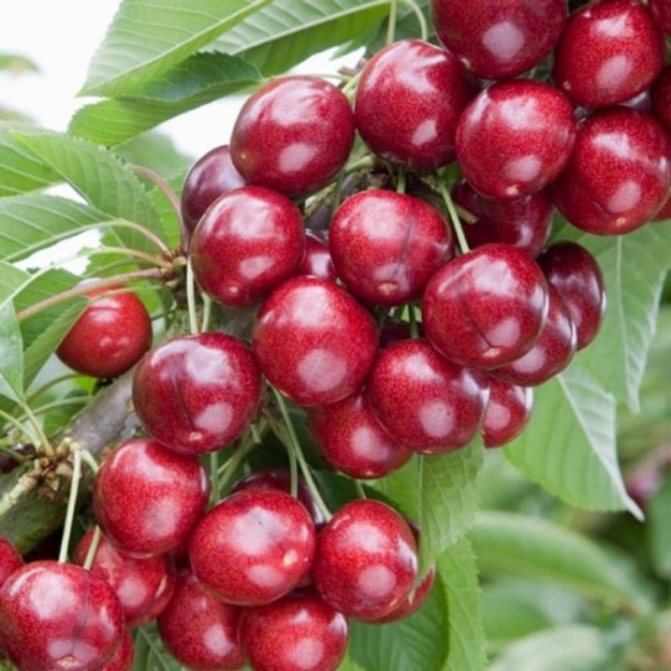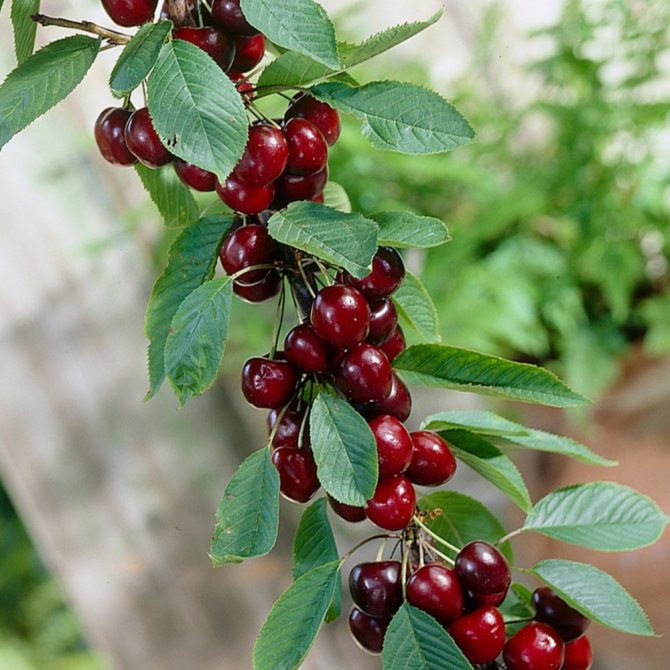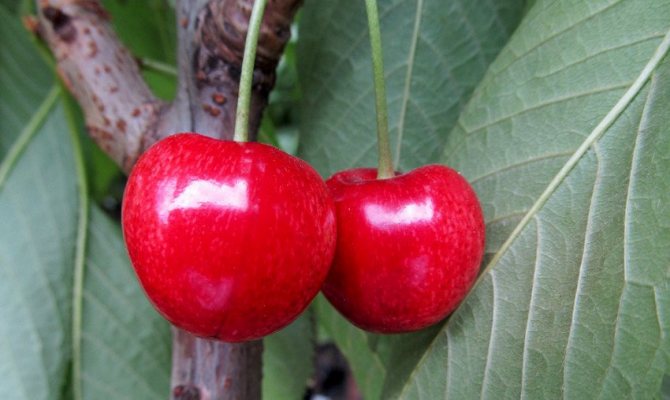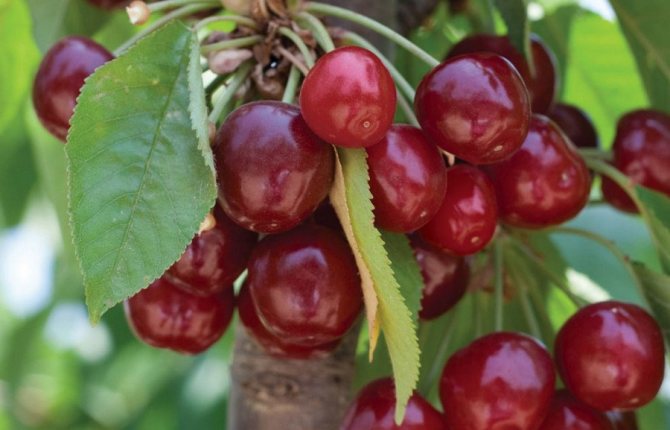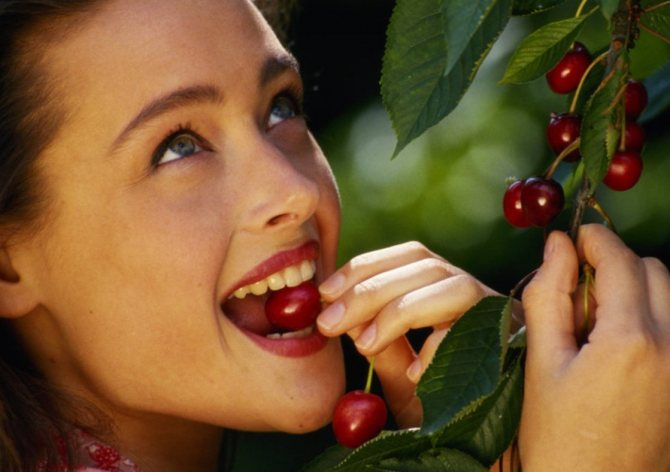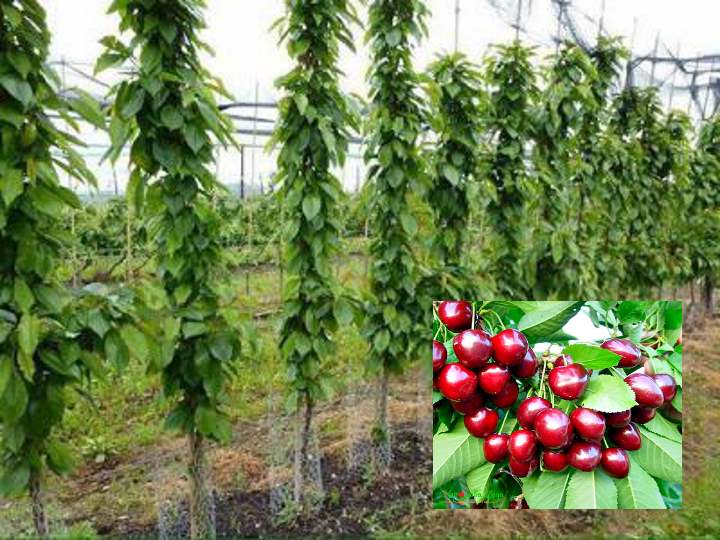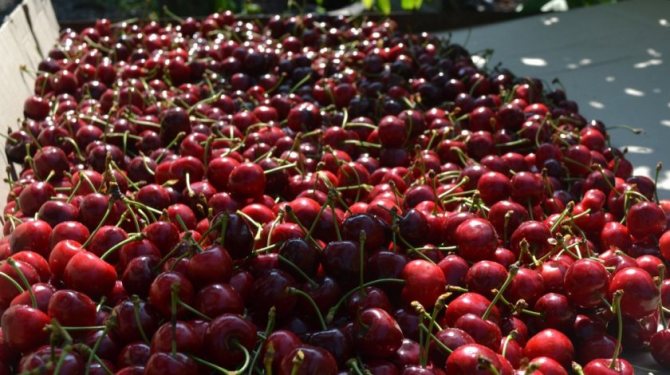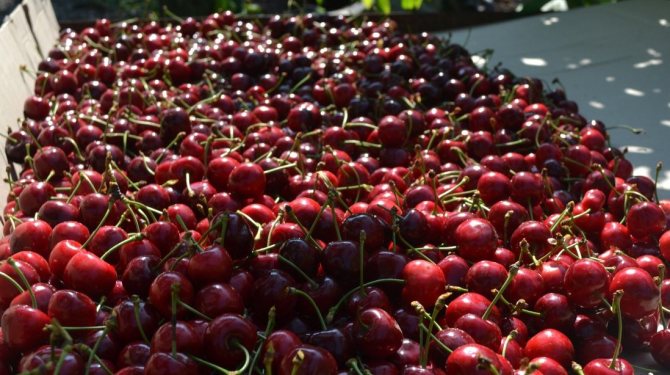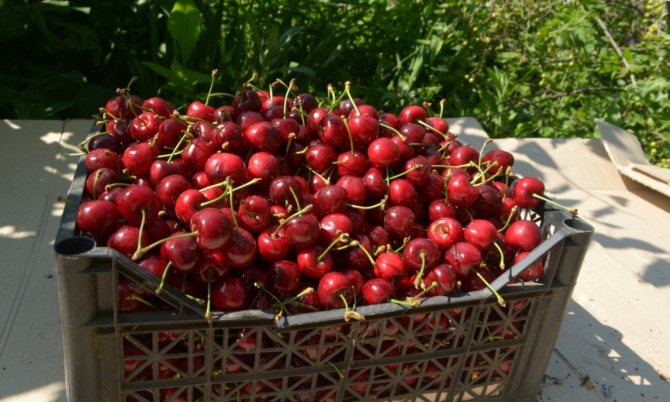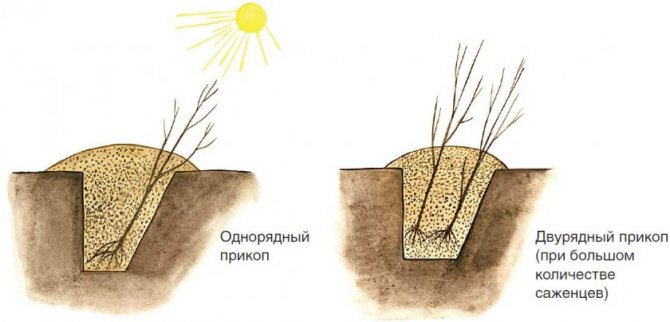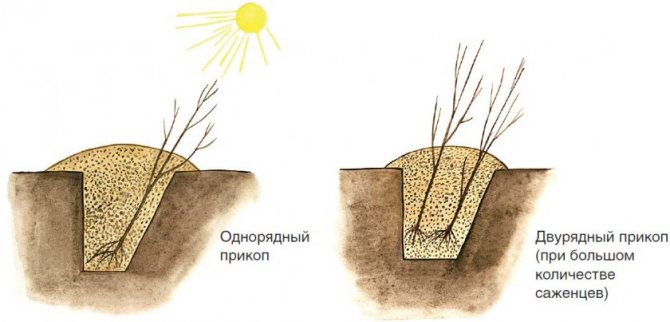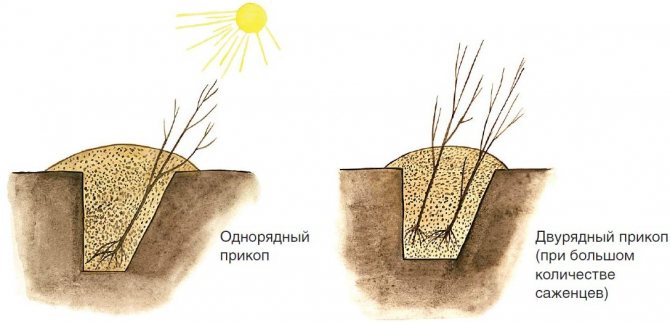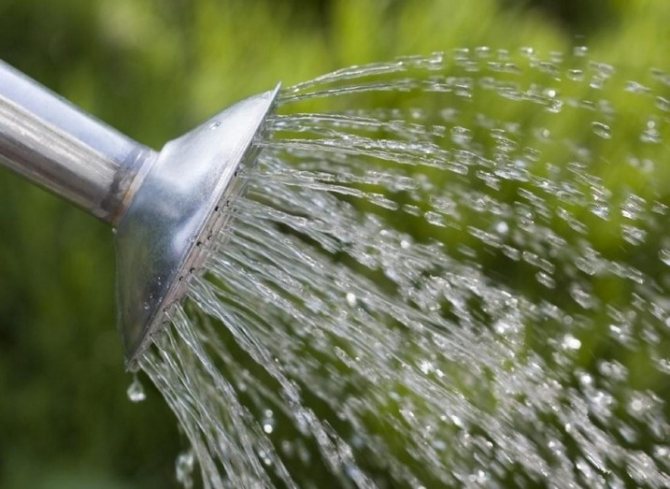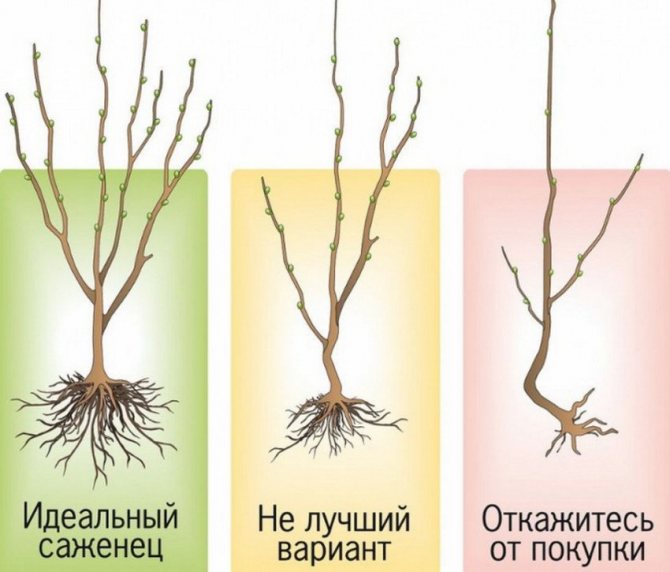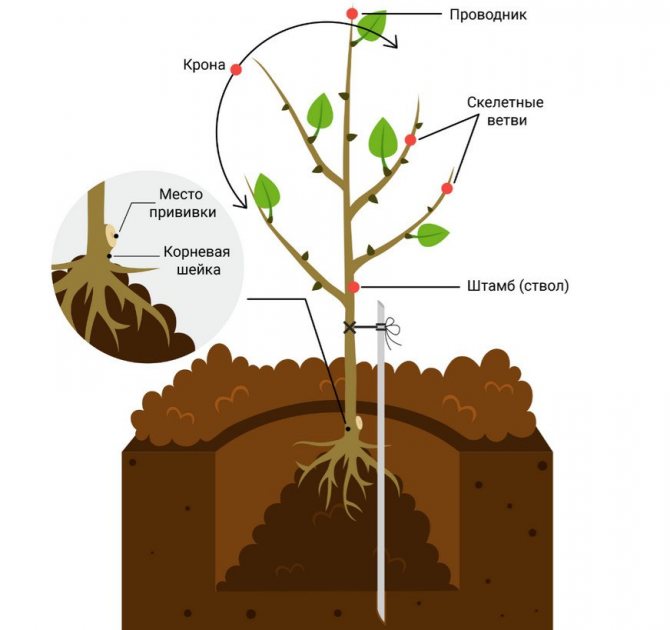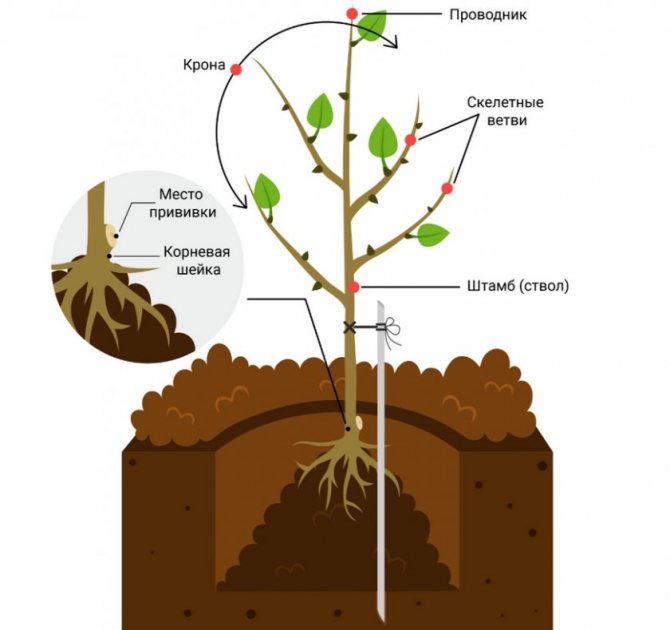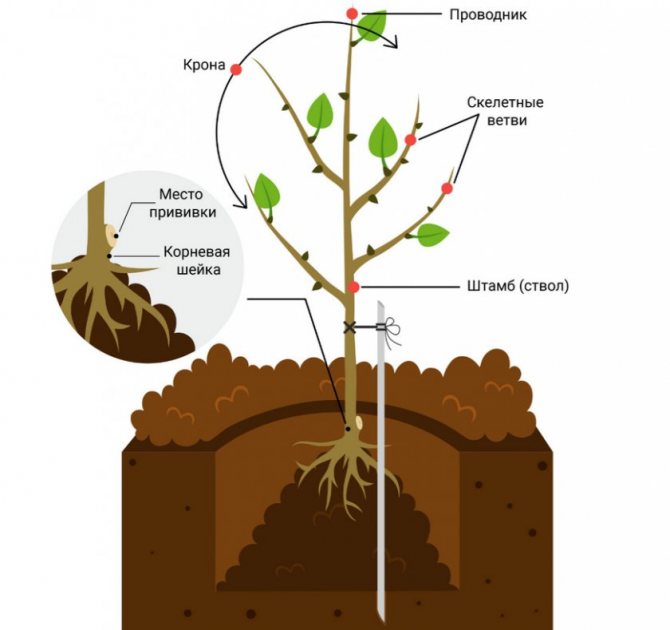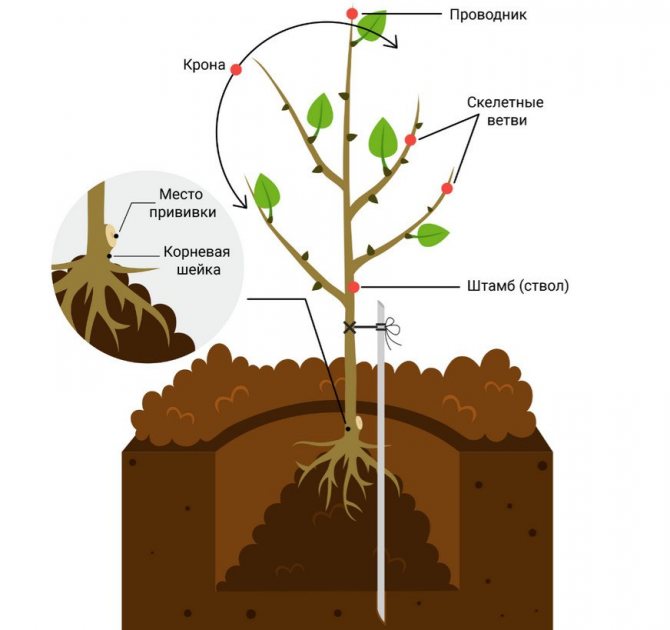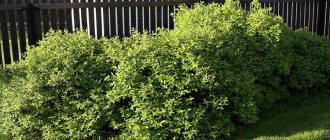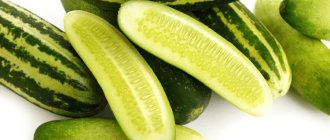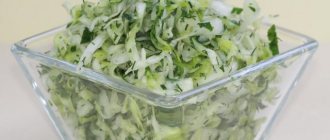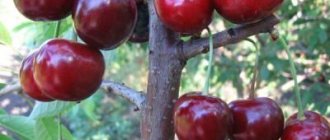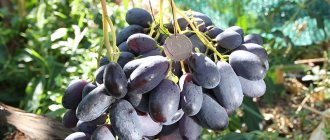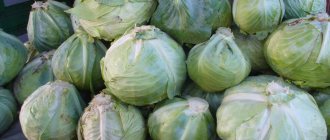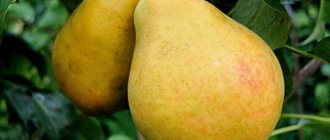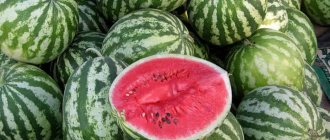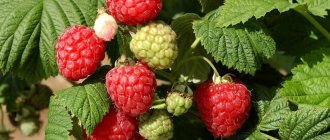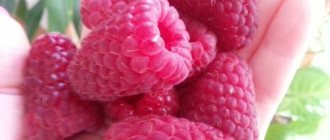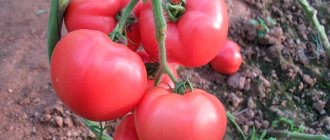Columnar cherries have recently been planted in Russian gardens, but they have already become popular. Unlike simple varieties with spreading crowns, a compact tree does not take up much space. Therefore, columnar varieties of sweet cherries are often grown in small summer cottages. Thanks to selection work, varieties have been developed that are suitable for breeding in different climatic zones. With proper care, they give a bountiful harvest, are undemanding to care, and tolerate seasonal cold snaps.
Description of columnar cherries
Outwardly, the columnar cherry is just a tree trunk with a few leaves, and looks like a column, which is where the name comes from. There are no spreading pagons, like an ordinary tree, but there are several branches, also covered with leaves. During fruiting, the trunk and a few branches of the tree are densely covered with cherry berries.
It is beneficial to plant such trees in small gardens, where there is little space, in summer cottages, where it is necessary to grow, in addition to trees, many garden crops. Columnar cherry does not cast a big shadow, like a simple tree, it is compact, has a high yield, if you provide it with proper care.
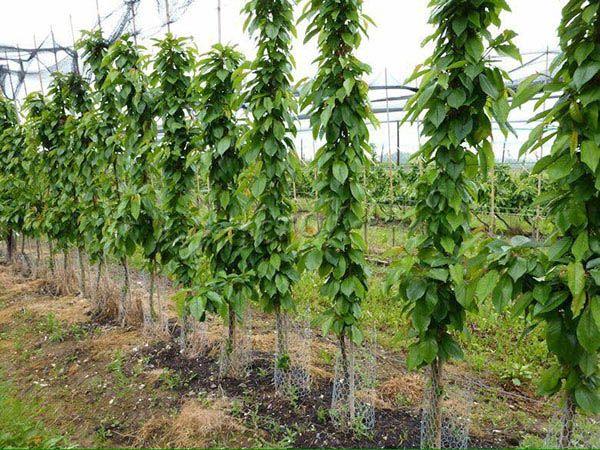
The columnar cherry tree takes up a minimum of space on the site
Diseases and pests
Cherry Helena is most prone to the following ailments:
- Clasterosporium disease - characterized by the presence of dark spots and small holes on the surface of the foliage.
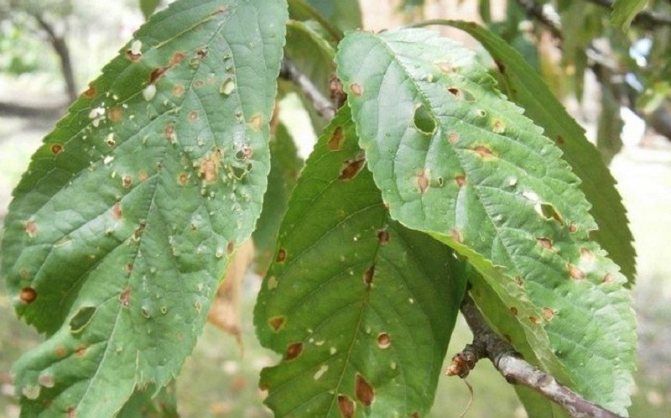

- Coccomycosis and moniliosis - decay of the root system and the green part of the tree.
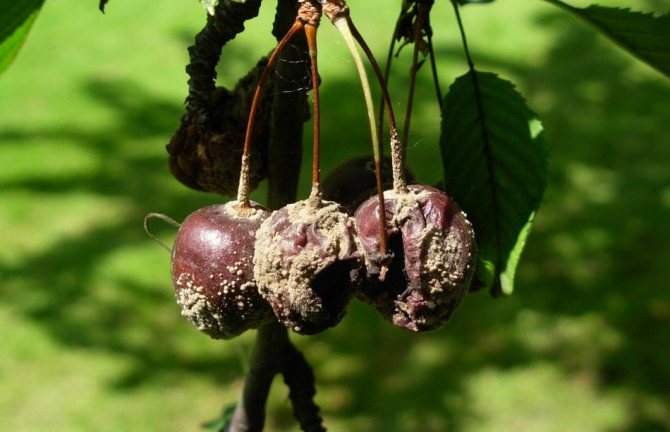

- Scab - a fungal disease that affects all parts of the plant. It is manifested by the presence of light olive spots, which later turn into rot.
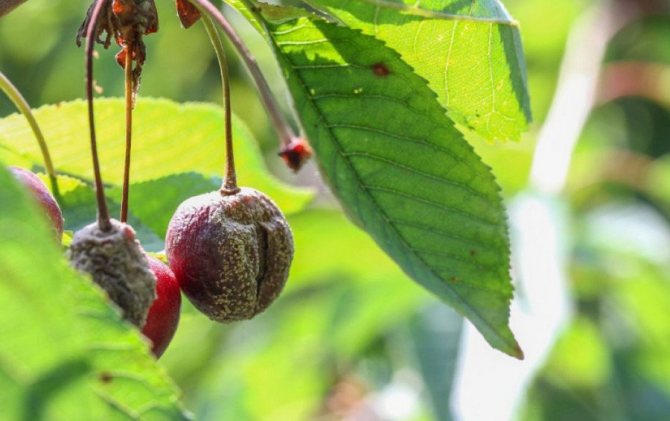

To combat the described diseases, 0.1% Bordeaux liquid is used, which is abundantly irrigated with a tree. It is important to carry out preventive treatments before and after flowering crops using the above preparation.
Learn how to deal with cherry diseases.
As for pests, when growing Helena, you need to be wary of the following:
- Sawfly - a small insect with transparent wings. The main blow falls on the fruits in which the pest larvae develop. Against this insect, a solution of karbofos is used at the rate of 90 g per 10 l of water, which is sprayed on a tree.
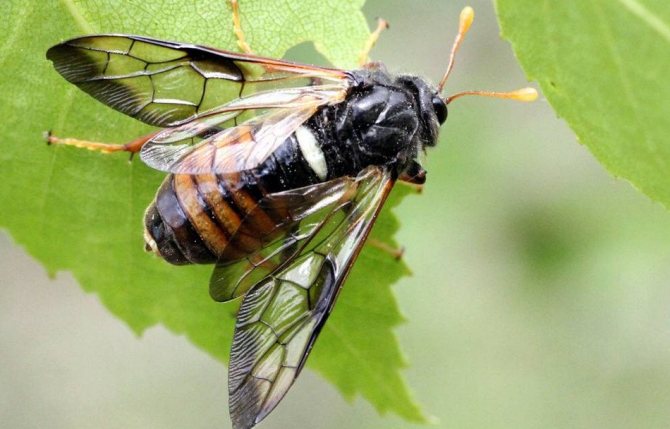

- Weevil - a bronze-green beetle that eats ovaries and foliage. To prevent the reproduction of the pest, it is necessary to dig up the soil of the near-stem circle, as well as whitewash the trunk of the sweet cherry. If the beetles are damaged, they are regularly shaken off the branches and the plant is treated with a decoction of wormwood - 1 kg of raw material is boiled for 10-15 minutes in a small amount of water, after which another 10 liters are added.
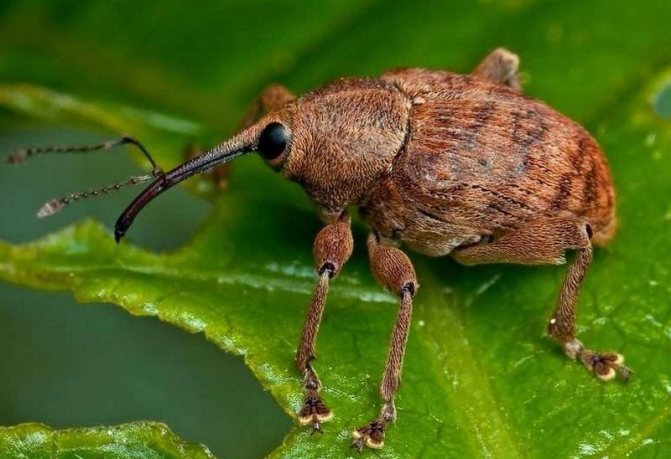

- Aphid - small black insects that feed on plant juices. When damaged by a pest, foliage is crowded, and young shoots are shortened. To combat it, it is necessary to spray the foliage with a soapy solution - for 10 liters of water, half a bar of grated laundry soap.
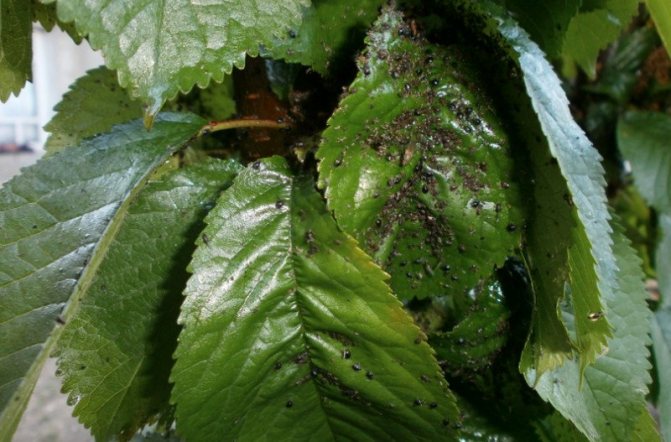

Advantages and disadvantages
Check out these articles as well
- Pear variety Lada
- Cherry compote
- Phalaenopsis Orchid
- Feed corn (feed)
Columnar cherry has a lot of positive qualities.
- The tree takes up a minimum of space on the site.
- No cropping is needed. And this greatly simplifies care, especially for young gardeners. Only in rare cases, it is possible to carry out sanitary pruning if the pagons are frozen or some diseases have appeared.
- The yield is high, regardless of the variety.
Important!
Any varieties of columnar cherries, even frost-resistant ones, must be insulated for the winter!
- The first fruiting is observed in the year of grafting of the seedling. If the tree was planted, then the harvest can be expected for about 3 years.
- The berries are tasty, usually large and juicy.
- The crop can be harvested both manually and mechanically.
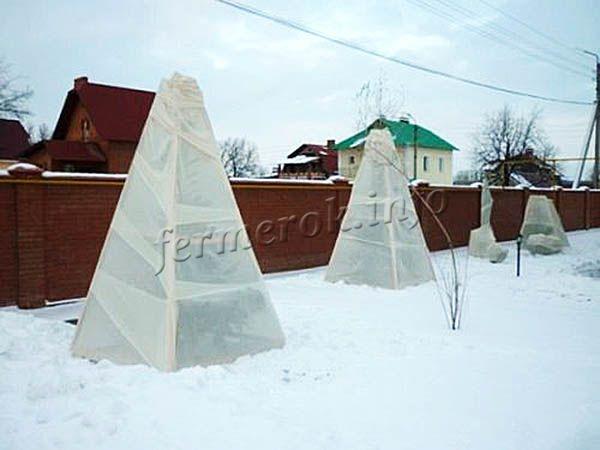

Any varieties of columnar cherries, even frost-resistant ones, must be insulated for the winter!
There are not many disadvantages of this type of sweet cherry, but they are.
- Such trees should be planted near natural or artificial wind shelters, because during a storm, the branches and the trunk of the tree itself can break.
- The tree is demanding for watering. It does not tolerate drought, but it will not be able to develop normally in swampy soil.
- Productivity is considered high for a columnar tree. But since these trees have not many branches, about 15 kg of berries are collected from the tree. In comparison with simple cherries, this is not much. But if you grow berries for your own needs, and not for sale, then the harvest will be enough.
Harvesting and storage
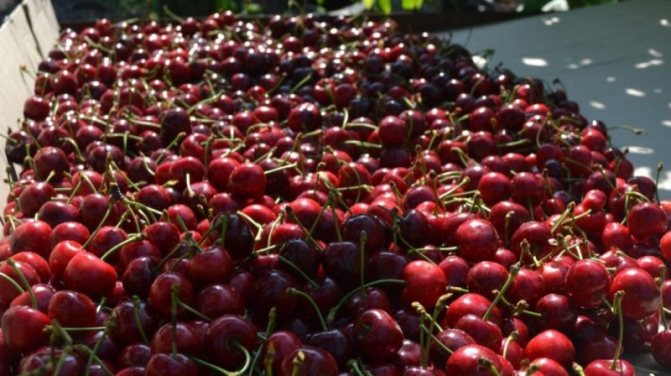

The crop is harvested in mid-June. The berries are plucked together with the "tails" first of all from the lower branches and gradually move to the upper ones.
The fruits are not prone to cracking, they tolerate transportation well and are stored without a refrigerator for 7-10 days, in the refrigerator for about 3 weeks.
The best varieties of columnar cherries
Columnar cherries can be yellow, red, or even almost black. There are not many varieties of such trees, but they have high quality characteristics.
- "Queen Mary" suitable for cultivation in the southern and middle regions. The variety is fruitful, about 15 kg of berries can be harvested from a tree per season. The berries are delicious, red in color. The rind is dense. The variety is suitable for transportation.
- "Yellow" - a variety of columnar cherries, gives yellow berries. Birds, as a rule, are not interested in this variety. The berries are tasty, sweet, suitable for long distance transportation. Harvest from a tree is not enough. The tree gives berries no more than 25 years!
- Helena - dessert type for cultivation in central Russia. Ripening is observed by mid-June. The culture grows up to 3 meters. The diameter of the tree is 1 meter. The variety is high-yielding, the fruits are pink-red, 14-15 g each. The pulp is dense, tasty, but there is not much juice in it. Fruiting for about 20 years, depending on the cultivation method and care.
- "Silvia" - cold-resistant variety for cultivation in temperate climates. Gives big yields. The tree bears fruit by mid-June. It grows up to 4 meters with a crown up to 1.5 meters in diameter. The berries are large, burgundy. Although the tree is frost-resistant, it needs reliable protection from strong winds!
- Little Sylvia - analogue of the Sylvia variety, only miniature. It grows up to 2 meters with a crown up to 50 cm in diameter. The berries ripen by the last days of June. They are also burgundy in color, incredibly tasty, sugary, dessert type.
- "Sabrina" - self-fertile type of columnar sweet cherry. Grows up to 2.5 meters. The crown is not thick. The berries are suitable for harvesting by the end of June. They are juicy, large, fleshy. The tree is resistant to cold weather, it is recommended for cultivation in the southern regions. It has a strong immunity to diseases and is rarely affected by pests.
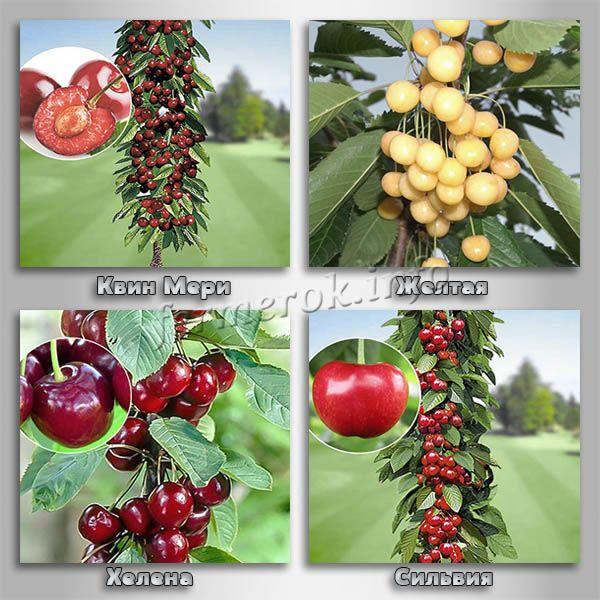

Columnar cherry varieties
Important!
Columnar varieties of cherries need the correct soil composition. The land must be fertilized, moderately loose and contain useful trace elements, so fertilize it several times a season!
- "Iput" - a well-known variety, often used for industrial cultivation. The harvest ripens by the 20th of June. The berries are burgundy, medium-sized, sweet, juicy, the stone leaves the pulp well. The crop is suitable for long-term transportation. Possesses persistent immunity to many diseases.
- "Tyutchevka" - mid-season, self-fertile variety. Ripens by early July. Burgundy berries with a dense skin and fleshy pulp. Weight - 3.5-4.5 g. Productivity is high. Fruiting for 25 years, then the culture must be replaced.
- "Sam" - an early variety of columnar cherry, recommended for industrial cultivation. The first harvest can be filmed on June 10! Used for growing alone or as a pollinator for other varieties of trees. Berries are medium in size, about 12 g, sugar, high in juice. The tree is capable of producing a crop for about 15 years.
- "Delight" - a variety of the mid-early ripening period. It grows up to 2.5 meters in diameter - 1 meter. The yield is regular and high. The berries are large, up to 14 g, pomegranate in color. Sugar, juicy taste, recommended for fresh consumption. Fruiting begins 3 years after planting.
How cherries reproduce
To obtain a second copy of the original cherry, the following propagation methods are used:
The stone is the most difficult and time-consuming process of cherry propagation. At the same time, the probability of obtaining maternal qualities at the output is 50%.
The seeds from the desired variety, fully ripe, are placed in a container, burying 1 cm into the ground. The soil for planting should be light, loose, mainly consisting of deciduous substrate, peat and river sand.
After planting, the soil is spilled with warm water and covered with plastic wrap to maintain greenhouse conditions. Regular airing and periodic water application allow you to quickly get a young seedling. After a year, the sprouts obtained can be planted at a permanent place of residence;
Vaccination - the pinning procedure is carried out on a 2-year-old seedling. As a grafted growth, you should take a stalk no more than 10 cm. Inoculate at a height of 1.5 m above ground level.
The graft should not be left in a single copy, but together with the lower branches of the plant;
Cuttings are the most commonly used method for propagating sweet cherries. To implement the method, a one-year shoot is selected, no more than 10 cm high. The lower edge is processed by Kornevin and placed in a flowerpot with loose, suitable soil. After rooting and the appearance of green shoots, the seedling is transplanted into open ground.
To obtain cherries, you can experiment with different propagation methods, but it is best to purchase a ready-made specimen with a good root system in the nursery.
Columnar cherry varieties for the Urals and Siberia
We recommend reading our other articles
- How often to water a cactus
- Black-and-white breed of cows
- The best table grape varieties
- Grape variety Augustine
Not many varieties of columnar cherries are grown in cold areas like the Urals or Siberia. As a rule, these are the most frost-resistant species, but even they need to be sheltered from frost for the winter!
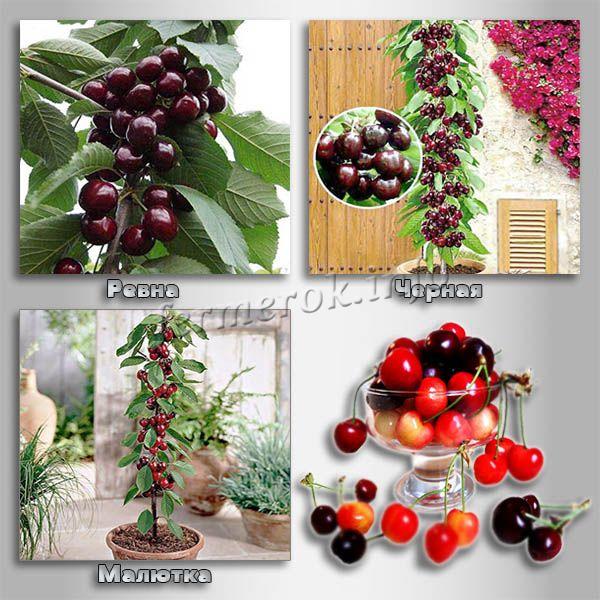

Columnar cherry varieties for the Urals and Siberia
- "Black" - unpretentious type of columnar sweet cherry. Grows up to 2 meters maximum. The tree bears great yields. It can be grown in the south, in the middle lane and even in the north of Russia. The berries are large, black and red, hence the name. The rind is glossy, dense, but edible.
- "Revna" ripens by early July. The berries are tasty and can be stored for a long time. Their weight is about 8 g. It is a frost-resistant variety, suitable for cold regions. Resistant to all fungal diseases.
- "Baby" - columnar, fruitful sweet cherry. The tree grows up to 2 meters, but usually shorter, the diameter of the tree is up to 80 cm.The berries are sweet and sour, with a strong aroma. The use is universal. The crop is suitable for both fresh consumption and canning. Recommended for cultivation in Siberia, but for the winter it must be covered!
Features of variety care
In order to regularly get rich harvests, you need to follow a number of simple recommendations, more about which are below.
Watering and loosening
Sweet cherries love moist soil, so it is important to ensure that the soil does not dry out. In the first two years of growth, the tree is watered daily during the growing season, using about 3 liters of water. Further, the procedure is carried out in such a way that the soil always remains moist. It is also necessary to take into account the weather conditions that can provoke stagnant moisture, which is detrimental to the culture.
Reviews about columnar cherry
It is difficult to find a good seedling of a columnar cherry, many gardeners complain about this, but in terms of growing, reviews about these trees are mostly positive.
- Diana Terentyeva: “We planted the columnar cherry because there is simply not enough space on the site. At first we chose for a long time, then ordered the Iput variety. After about 2-3 years, the first berries appeared. At first it was not enough, but every year the harvest is growing. The berries are delicious, like a simple cherry, sweet, but larger. I like that the tree does not take up much space, gives almost no shade - you can plant greenery or other plants under it. So I recommend it to everyone. "
- Vadim Stokar: “My wife and I, what unusual trees have we tried to grow in our garden. There were both good experiments and unsuccessful ones. About 3 years ago, we purchased a columnar cherry "Black". It did not take root for a long time, and soon the leaves began to grow (they were planted in the spring). This year the first berries were tasted. Very tasty - sweet. Berries are a feast for the eyes. Now we will look for other columnar types of trees, because they really save a lot of space on the site. "
- Alexandra Grischuk: “Initially I thought that the columnar cherry is the most unpretentious tree, but it turns out that it requires constant care. At first, you only need a place for him to find a good one, but then, when he grows up, it is important to water and feed on time. With any delay, postponement, it begins to fade, slow down development. For the winter, we definitely insulate so as not to risk it. But, in general, my impressions are satisfactory. The fruitful tree gives very tasty berries, so time is not wasted. "
General requirements for agricultural technology
Activity and maximum yield depend on correctly selected agricultural techniques. The main requirements of agrotechnical measures consist of the following factors:
- the right choice of seedlings;
- selection of a place;
- soil preparation;
- digging holes;
- compliance with the optimal distance;
- fertilization;
- pruning;
- watering;
- loosening the soil or mulching;
- preparation for wintering;
- prevention.
Selection of seedlings
The choice of seedlings is carried out according to the general principle - no damage, signs of disease, discoloration of shoots and stems, integrity and freshness of the root system.
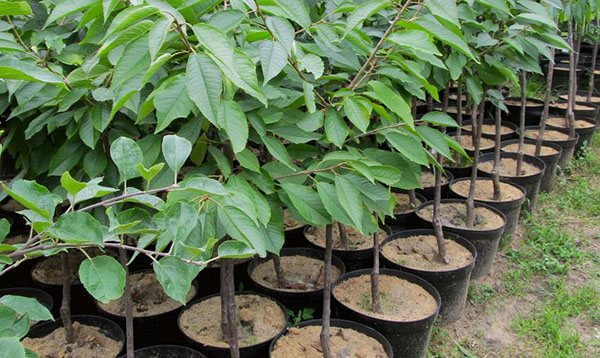

When choosing a columnar cherry seedling, make sure that the upper bud is alive, not broken.
Choosing a landing site
An equally important factor is the choice of a place for the future garden.
The terrain should be flat, without the possibility of drafts and the presence of nearby buildings. But you should also avoid swampy and clayey areas.
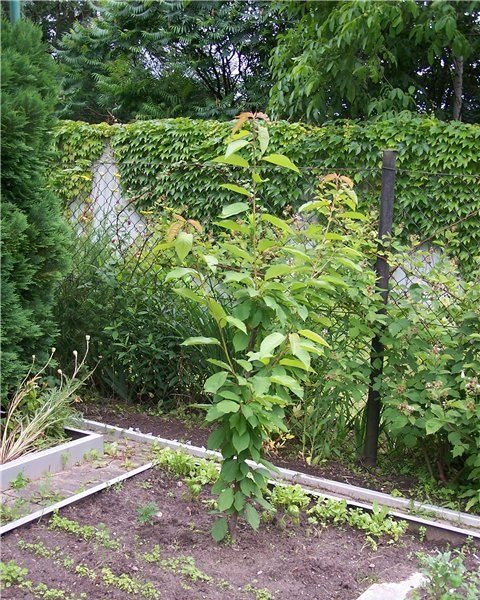

Choose a sunny place for your cherries, where there are no strong winds.
If there is a likelihood of close groundwater occurrence, it is necessary to create a thick layer of drainage flooring inside the pit. Next, phosphate and potash fertilizers are mixed with the soil, placed in a hole, left for fourteen days to reduce the concentration.
- Distance between plants must be at least three meters, the gap between the rows - 1.5 m.
- Fossa depth about 80 centimeters - depends on the size of the root system.
Watering
Watering the planted garden is carried out every week for the first few months, at the rate of a bucket of water per tree.
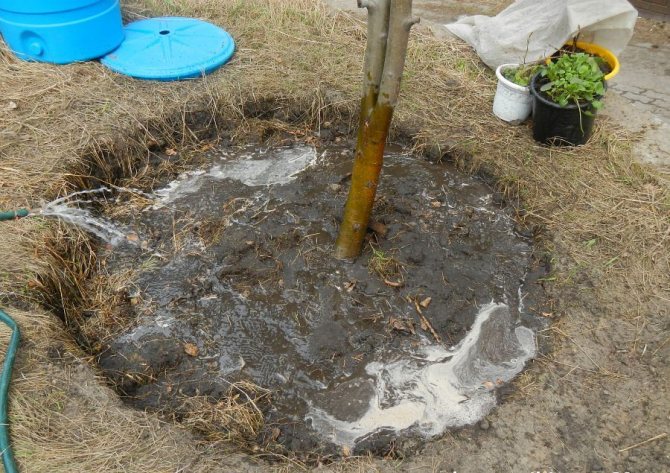

An adult cherry tree needs at least six buckets of water per week during fruiting.
If the weather is dry, it is recommended to increase the amount of water to two buckets. For the rest of the time, if there is a normal level of sediment, trees are watered at least once a month. Stop watering during a long rainy season. The surface can be mulched to retain moisture and condition the loose soil.
It is noteworthy that planting should be carried out in early spring or autumn. In the conditions of the Moscow region, priority is given to spring planting.
Landing features
It is important that no more than six hours pass between the acquisition of planting material and the planting itself, since the roots of colonial varieties are prone to rapid drying.
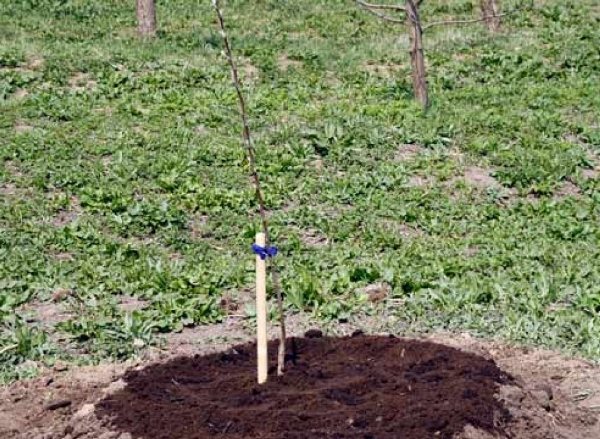

Immediately after planting, the seedling is tied to a vertical support.
Pruning
Trimming is carried out according to the scheme.
- In the first year cultivation, it is necessary to pinch the shoots that have grown from the sides ten centimeters from the main trunk, and cut the top off.
- Next year pinch the shoots from the sides by 20 cm, and let the top grow up to 30 cm, and then pin it.
- In the third year the upper shoot is cut off, and the lateral ones are reduced by 30 cm. Further, all small, thin and weak branches are eliminated.
- After five years the growth of the tree should be stopped at about three or two and a half meters. The rest of the time, only lateral shoots are removed.
Planting and leaving
Columnar cherry varieties Helena
It is recommended to plant in the spring, when frosts no longer appear.
Choose a suitable spot before boarding. It must be protected from the northerly winds.
For this reason, it is recommended to lean towards enclosed areas near a house or fence on the south side. The sun's rays should hit the seedling, as cherries like good lighting. It should be planted in fertile soils.
For landing, you must adhere to the following rules:
- Initially, a hole is dug.
- A mixture of black soil and humus is poured into the bottom in a rammed hill. This will create favorable conditions for the growth of the seedling.
- You should not use mineral fertilizers when planting, as they negatively affect the rhizome of a young tree.
- The seedling is placed on a hill, the roots are straightened, it does not go deep.
- Finally, the tree needs to be watered.
Young cherries do not grow quickly, and the top may not form until the beginning of winter. For this reason, it is worth covering it so that it does not freeze.
Caring for a tree does not require much effort. For normal development, cherries need loosening of the soil, normal watering and protection from pests. To protect the tree from harmful insects, it is recommended to spray it with a fungicide solution in the spring.
Characteristics of fruits and trees
Columnar trees differ significantly from ordinary trees, but in order to distinguish Sylvia cherries from the rest, you need to know its description in more detail.
Crown height and density
Columnar dwarf trees. Sylvia's height, even on a wild stock, does not exceed 3 m. Its trunk is erect and has practically no lateral branches. All shoots grow vertically. The crown is dense, cylindrical. Practically does not need shaping.
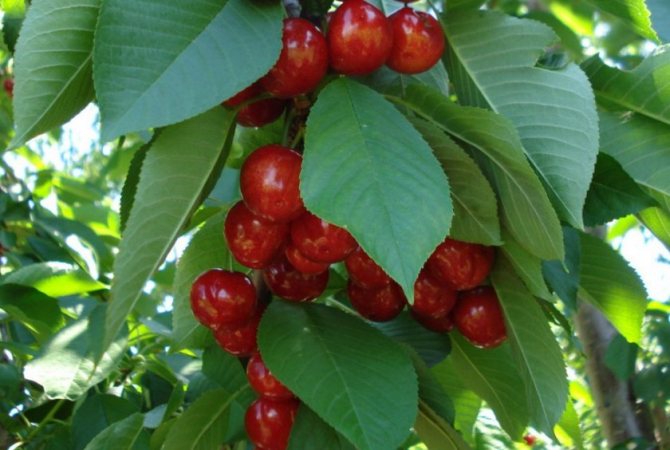

Scientists have also developed a variety of the Sylvia variety - Little Sylvia
Taste qualities of fruits
Ripe dark red berries with a shiny skin. The density of the fruits is average. The pulp is deep red, crispy, juicy. Her taste is excellent, bright. In terms of taste, Sylvia was rated 4.9 out of 5 points.
Description and features
An adult columnar tree is much shorter than a regular sweet cherry. It has a straight-growing trunk, almost hidden by foliage, with short skeletal branches. Its height is up to 3 meters. The breadth does not grow, and the crown consists of skeletal and fruit branches along the entire height in the form of a cylinder.
In the garden, such a tree actually does not take up much space, and this was appreciated by gardeners and summer residents. The distance between columnar trees can be small, it is enough to plant them at a distance of up to one and a half meters from each other. Despite its small size, the yield of the tree is high. Three of these trees, planted on the site, may well replace an ordinary tree.
Many owners of household plots in Moscow and the Moscow region liked the unpretentious and fruitful columnar trees. Gradually, these trees with a beautiful cherry blossom began to appear among summer residents in their gardens.
Additional Information. When breeding varieties of columnar cherries, breeders used a dwarf rootstock. Starting from a shallow root system that is not able to form a large crown, a species was bred in nurseries that gives all its strength to fruiting. That is why such a great fertility of columnar varieties.


